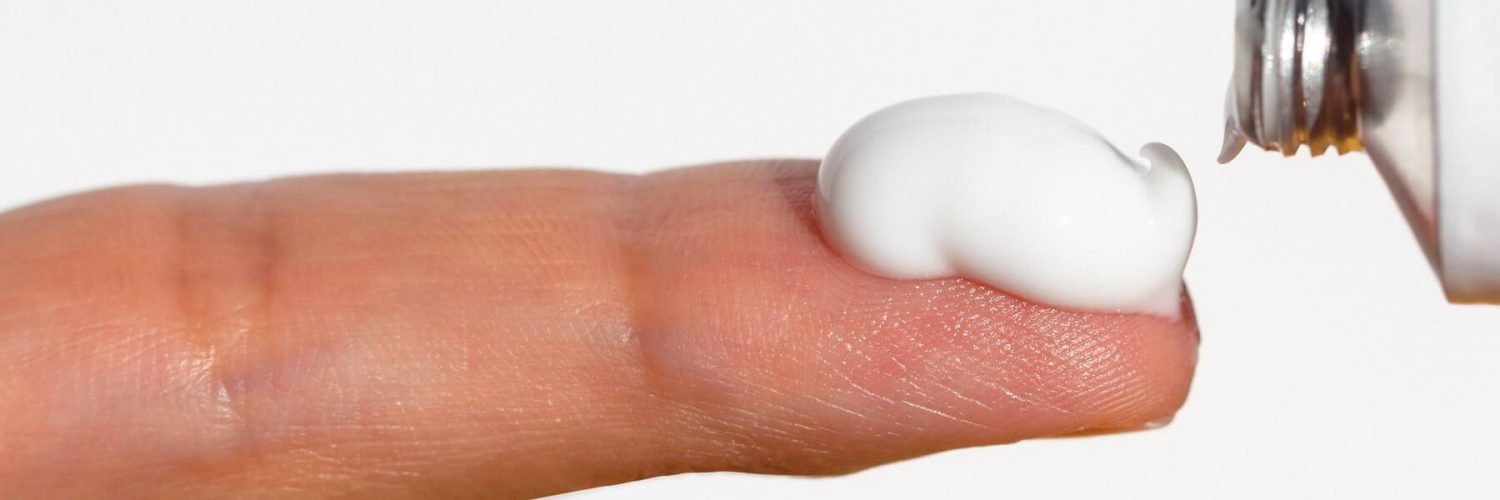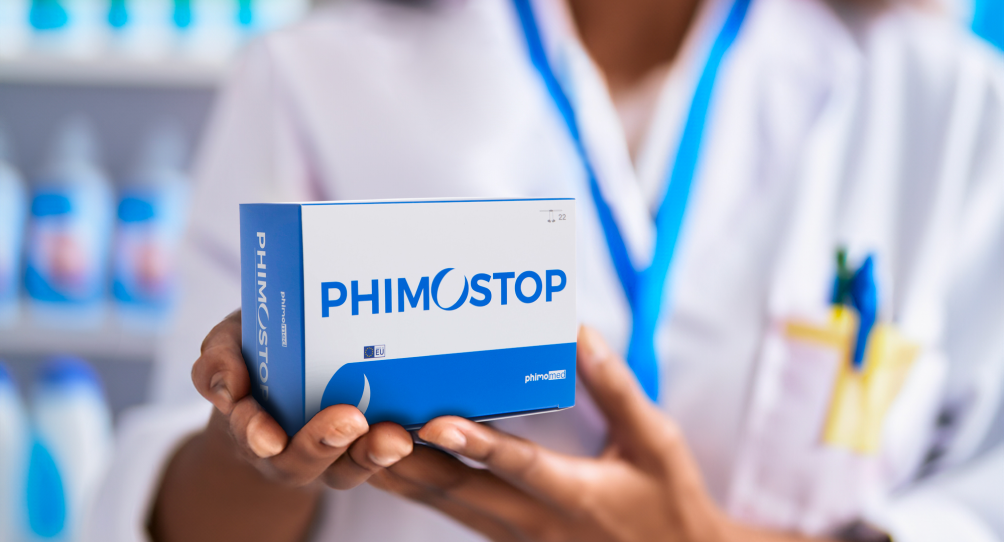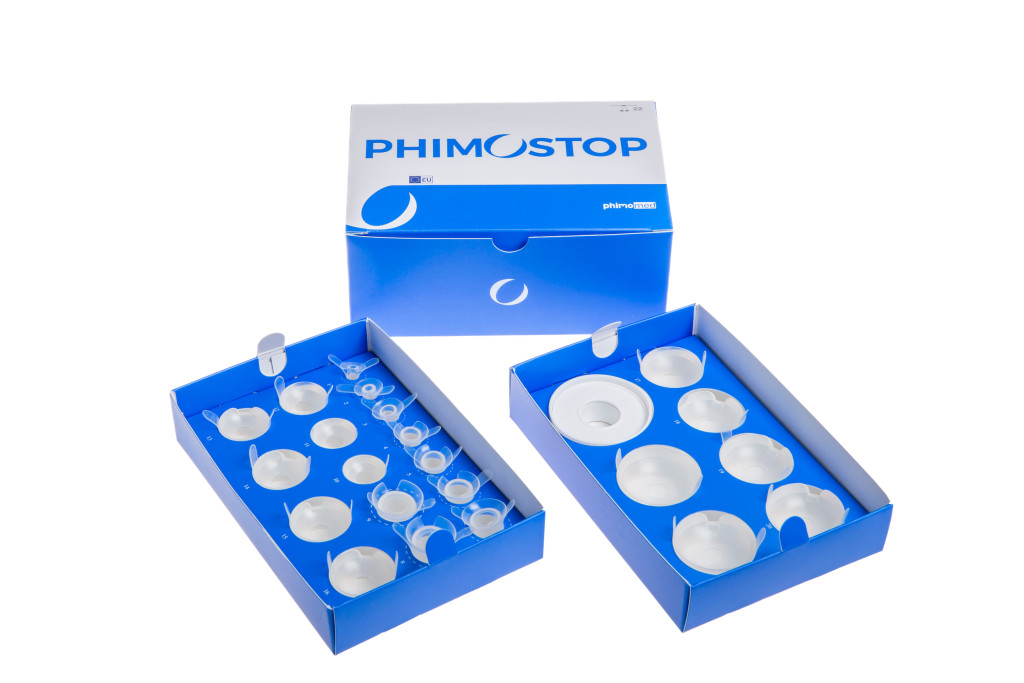Phimosis treatment: available therapies and cures
Co-authors of the page:
– Dottor Stefano Germani Medical Director UOSD – Fondazione Policlinico Tor Vergata, Rome.
– Dottor Roberto Miano Associate Professor in Urology at the Faculty of Medicine, University of Rome Tor Vergata.
Phimosis is a medical condition whereby it is difficult or impossible to uncover the glans of the penis due to a narrowing of the foreskin. It is a potentially disabling condition that affects male genital anatomical morphology and becomes a cause of possible complications or disease.
In this article, we will review the different treatments available, from traditional therapies to more innovative approaches such as Phimostop.

What's on this page:
Phimosis: definition and types
Phimosis is a medical condition affecting men, characterized by the difficulty or inability to uncover the glans of the penis completely due to a narrowing of the foreskin. Under normal conditions, however, the phimotic ring is elastic enough to allow retraction of the foreskin, thus allowing exposure of the glans.
At the time of birth, all male infants have natural balano-preputial adhesions that serve the function of protecting the penis. Around the age of 3 or 4 years, the growth process of the penis and, consequently, the foreskin begins, which spontaneously eliminates these adhesions. However, in about 1% of cases, it occurs that the foreskin does not develop in proportion to the penis. This may result in an inability to uncover the glans due to a deficiency of foreskin tissue: in this case, we speak of congenital phimosis.
In other cases, phimosis may occur in adulthood as a result of infection of the foreskin or glans. Even after the infection is treated, the resulting scars may harden over time, forming a ring of inelastic phimotic tissue known as a phimotic ring. This process creates a kind of “noose” of rigid skin that prevents exposure of the glans.
PHIMOSTOP
Treating Phimosis without Circumcision
Phimostop is a medical device consisting of 22 medical silicone elements designed to help resolve phimosis, a condition in which the foreskin cannot be fully retracted onto the glans of the penis.
Phimosis: remedies and types of treatment
One of the most common questions from phimosis sufferers is: how to cure phimosis on its own? As mentioned earlier, during the first years of life, phimosis is a normal anatomical feature in the male genital system, and it usually resolves spontaneously by age 5. Initially, therefore, phimosis is not considered a pathology in itself.
It is important to note that if this condition persists beyond childhood, develops into adulthood, or is not properly managed, it could lead to potentially serious consequences, negatively impacting the quality of life of affected men.
But how is phimosis treated? Below we will look in detail at the currently available treatments for phimosis.
Treatment for phimosis with stretching exercises
Some websites claim that stretching exercises performed at home, characterized by the slow movement of the foreskin in the act of covering and uncovering the glans, can be an effective remedy for phimosis.
However, it is essential to point out that these claims are often misleading.
Forcing the phimotic tissue may result in the formation of small tears on the foreskin, which, as they scar, are likely to aggravate the existing condition of phimosis. In addition, such exercises often suggest the use of lubricating creams and ointments, supposedly aimed at facilitating the movement and treatment of phimosis.

In reality, numerous medical and scientific investigations have shown that the use of lubricating ointments in no way resolves foreskin shrinkage. Even in the event that temporary results were achieved through slow movement of the foreskin, there would be no certainty of long-term improvement, with the risk of phimosis recurring in a more severe form.
Such exercises may have some utility only in the presence of extremely mild phimosis, such as early degrees of non-tight phimosis. However, because of the potential complications described above, they are always discouraged by medical professionals.
Treatment for phimosis with steroid-containing ointments
An alternative for the treatment of phimosis is the use of steroid-containing ointments.
The application of ointments for phimosis is a recommended therapy before considering circumcision surgery, especially in cases of congenital phimosis manifested at a young age. This therapy mainly intervenes in areas where a phimotic ring is not yet present, that is, where a “loop” of inelastic cells has not yet formed. The effects of such therapy depend on the type of phimosis and the patient’s individual response.
It is important to note that the available scientific evidence mainly focuses on research concerning congenital phimosis at a young age. This is relevant because phimosis in youth is significantly different from that found in adulthood; congenital phimosis itself evolves over the years.

The scientific study, conducted by the Department of General Surgery at the Royal Children’s Hospital in Australia and led by C. S. Kikiros, S. W. Beasley and A. A. Woodward, analyzed the efficacy of phimosis ointment therapy (of three different types) on a sample of ages up to 16 years with varying degrees of congenital phimosis. The analysis group concluded that local application of a steroid ointment on the foreskin resulted in resolution of congenital phimosis in more than 60 percent of cases, but the presence of a circumferential white scar (phimotic ring) reduced the likelihood of response to therapy. In addition, after discontinuation of steroid cream, return of phimosis occurred in a percentage of patients.
In summary, while there is research supporting the usefulness of this procedure for congenital phimosis at a young age, there is a lack of studies confirming the efficacy of the treatment in adulthood and especially for acquired phimosis. The key difference lies in the different anatomical manifestations of the problem, with congenital phimosis characterized by lack of growth of the foreskin and acquired phimosis associated with the formation of a phimotic ring caused by infection.
Phimosis surgery: the circumcision
The traditional therapy to treat phimosis, especially in cases of tight phimosis, is circumcision surgery.
Circumcision is the partial or total surgical removal of the foreskin, the part of skin that covers the glans. Phimosis circumcision removes the foreskin making the glans always uncovered. The glans is then no longer covered and develops a layer of keratin with a protective function.
Partial circumcision involves removal of only part of the foreskin, while full circumcision involves complete removal. Circumcision surgery is generally performed on an outpatient basis, although public facilities sometimes experience waiting lists that can range from two weeks to two years. Postoperative recovery time usually extends from three to four weeks.
Although total circumcision is a definitive solution for phimosis, there are two aspects that we believe are severely limiting:
- The psychological impact on the patient;
- The irreversibility of removal.
Removal of the foreskin using a scalpel is not an operation without challenges, both from a psychological point of view, given the idea of undergoing surgery on one’s sexual organ, and because it involves a visible change in the appearance of the penis, with the loss of a more or less significant part.
Phimostop: cures phimosis without surgery
In addition to these traditional and invasive therapies, there stands Phimostop, recommended for minor, major or intermediate forms of phimosis, especially when the patient demonstrates a strong motivation to avoid surgery.
Phimostop is a medical device, valid by the Italian Ministry of Health, consisting of 22 medical silicone tuboids designed to help treat phimosis.
But how exactly does Phimostop work?
First, one must select the appropriate tubes according to the type of phimosis, wearing it on the glans without exerting excessive pressure on the foreskin or causing pain. At this early stage, it is advisable to avoid immediately moving to higher gauges.
Before wearing the tuboid, it is important to wash your hands and the device thoroughly with soap and water. You can keep the tuboid moist to facilitate insertion and, if necessary, gently lubricate the mouth of the foreskin with lubricating creams, avoiding applying lubricant to the outside of the foreskin.
As the phimotic ring dilates, you can move on to the next tuboid. It is essential to follow all the steps using as many tuboids as necessary, without skipping any step. The process ends when the foreskin can slide freely at the base of the glans without restriction, even during erection. It is not always necessary to reach the last tuboid.
Phimostop represents the only medical device approved by the Italian Ministry of Health for the non-surgical treatment of phimosis.
Phimostop represents the only medical device approved by the Italian Ministry of Health for the non-surgical treatment of phimosis.

Discover more

